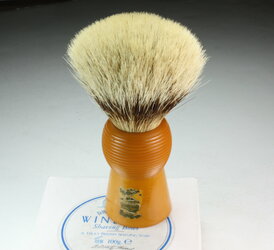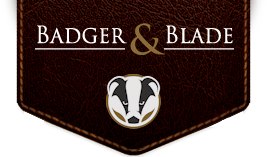I came across this nice old Kent butterscotch the other day. What caught my eye (besides butterscotch, of course) was the condition of the knot. In my experience it isn't common to find an older brush with the knot in excellent, or even usable, condition. but as you can see, this one is in top notch condition. It's a 22mm knot set at a loft of 47mm. Unfortunately, the seller of this had it "displayed" on one of those old jar/stands with the nasty spring steel clips. I'm assuming that the deep scratches on the handle are from being forced in and out of this clip; though I paid more than I would have liked, I considered it a "rescue" for this fine old brush. At least that's what I told my wife.
It is marked T17, Pure Badger, Made in England. I have seen a listing for this brush in a Kent catalog from circa late 1930s, but I'm not sure how long it was offered by Kent so I don't really know how old it is.
My curiosity is about the type or grade of badger. My understanding is that Kent labeled all their badger knots as simply "pure badger", without any further identifiers or distinctions regarding grade. This knot has very soft tips, and while it isn't super dense, it has at least decent backbone. To me, this looks (and feels) like silvertip, at least based on the ones I'm familiar with. What do you guys think?

It is marked T17, Pure Badger, Made in England. I have seen a listing for this brush in a Kent catalog from circa late 1930s, but I'm not sure how long it was offered by Kent so I don't really know how old it is.
My curiosity is about the type or grade of badger. My understanding is that Kent labeled all their badger knots as simply "pure badger", without any further identifiers or distinctions regarding grade. This knot has very soft tips, and while it isn't super dense, it has at least decent backbone. To me, this looks (and feels) like silvertip, at least based on the ones I'm familiar with. What do you guys think?







